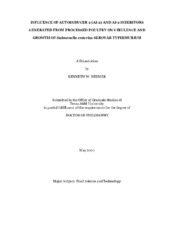| dc.description.abstract | Bacteria produce and respond to external stimuli using molecules termed
autoinducers. Poultry meat contains inhibitors which interfere with AI-2
signaling. The primary objective of this work was to understand the effects of
AI-2 on the virulence and growth of Salmonella Typhimurium, and if the
introduction of AI-2 inhibiting compounds would influence these effects.
Using DNA microarray analysis, expression of 1136 virulence-related
genes in a Salmonella Typhimurium wild type and a luxS mutant strain, PJ002
(unable to produce AI-2), was monitored after exposure to treatments
containing in vitro synthesized AI-2 (AI-2) and poultry meat (PM) inhibitors.
Responding gene expression was unique in the presence of AI-2, with 23 genes
differentially expressed at least 1.5-fold (p < 0.05). The combined AI-2 + PM
treatment resulted in 22 genes being differentially expressed. Identification of
inhibitory compounds was attempted using GC analysis on a hexane solvent
extract obtained from a PM wash. From this analysis, chemical standards of linoleic, oleic, palmitic, and stearic acid were tested for inhibition using V.
harveyi BB170. Combined fatty acids (FA) demonstrated inhibition against AI-2
at 60 % while 10-fold and 100-fold concentrations had inhibition of 84 % and 70
%, respectively. Growth of PJoo2, was studied using M-9 minimal medium with
FA of varying concentrations, supplemented with either AI-2, or 1X phosphate
buffered saline (PBS). Comparative analysis was done calculating the growth
constants based on OD 600 values for each treatment. No significant difference
in the combined FA + AI-2 treatments was observed against the AI-2 treatment.
A significant increase in the growth rate constants of the AI-2 treatments was
observed, however, compared to the PBS control (P = 0.01). Bacterial
invasiveness, using a murine macrophage cell line, RAW 264.7, was also studied.
AI-2 decreased cell invasiveness (P = 0.02), while the addition of combined FA
improved invasiveness to normal levels. The results of these studies indicate
that AI-2 does have an effect on the growth and virulence of Salmonella, but this
is not uniformly modulated by the introduction of fatty acids, that inhibit AI-2
activity, suggesting that inhibition may be based on species specific transport
systems. | en |


